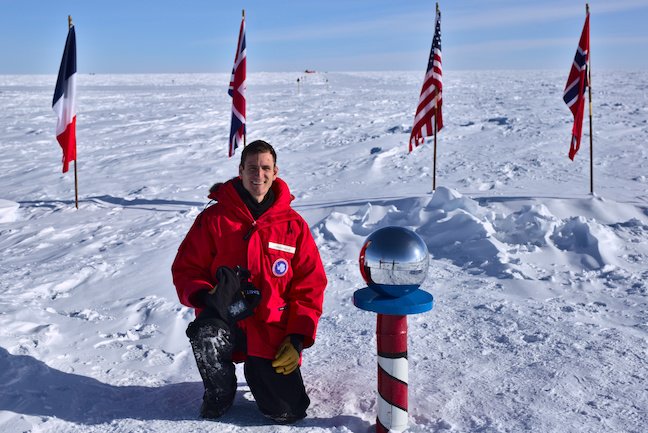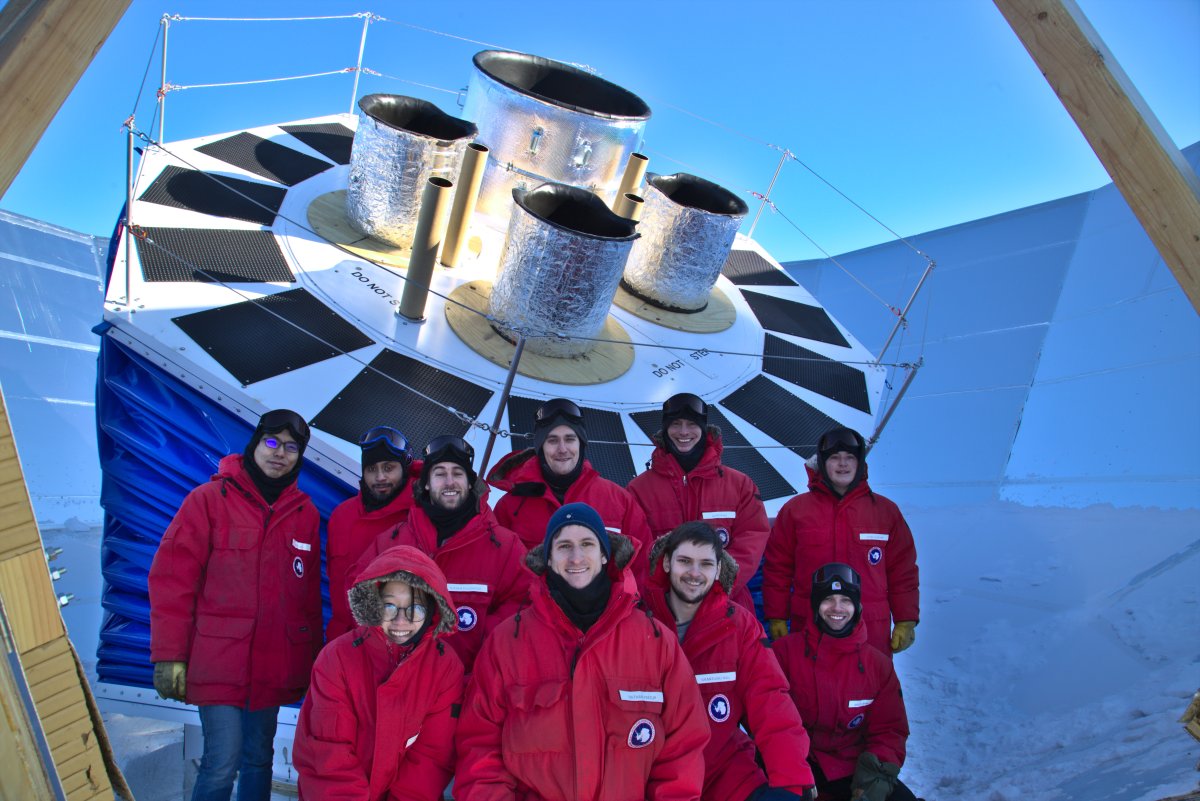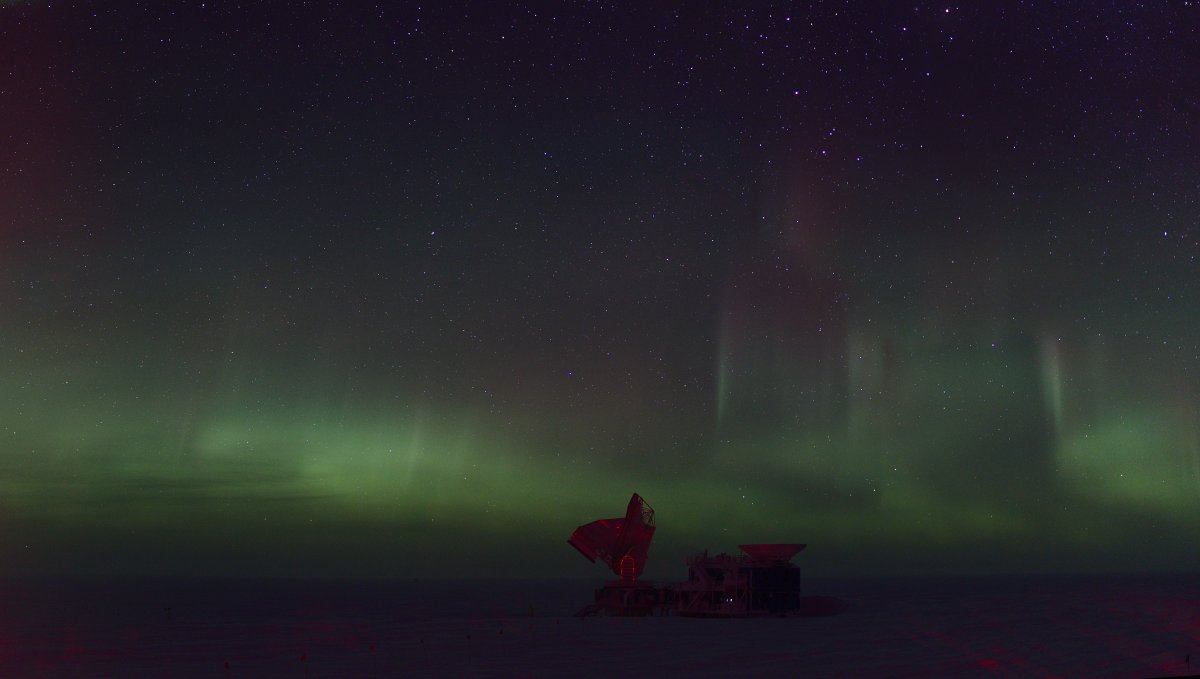Tales from the South Pole

Above: College of Science and Engineering researcher Nathan Precup is spending an entire winter at the South Pole monitoring and operating the BICEP Array—a composite of four telescopes gathering data on the cosmic microwave background of the early universe.
Photo credit: Nathan Precup
BICEP telescope researcher dishes on spending a year in Antarctica
June 17, 2020
Nathan Precup arrived in Minnesota in the midst of the famed polar vortex. It was January 2019, and the thermometer read -25 degrees Fahrenheit.
But that was just a taste of what was to come for the West Coast native.
Precup is now approaching the halfway mark of his “winter-over” year at the South Pole, where outside, the temperature is -118 degrees Fahrenheit with wind chill. The College of Science and Engineering researcher spends his days monitoring and operating the BICEP Array, a composite of four telescopes currently scanning the universe for gravitational waves that could provide insight into how the universe began.
Funded by the National Science Foundation, the BICEP (Background Imaging of Cosmic Extragalactic Polarization) team is led by CSE physics professor Clem Pryke and colleagues at Harvard, Stanford, and Caltech. The telescope mount was assembled in the University of Minnesota’s Physics and Nanotechnology building before the researchers brought it to Antarctica in November.
As the sole member of the team staying at the South Pole, Precup’s job over the next six months is to ensure the BICEP Array collects as much data as possible.

The polar express
Precup holds both a bachelor’s and a master’s degree in aerospace engineering from the University of Washington in Seattle, where he worked with wind tunnel systems before landing the BICEP position.
Getting the job was one thing, but preparing for and getting to the South Pole was a completely different beast, Precup explained.
First, a thorough medical exam. Winter-over researchers—those who spend an entire winter in Antarctica—must be healthy enough to live a year in isolation without emergency medical help readily available. Second, an abbreviated week of firefighting or medical training in Colorado. Then, the journey itself.
The researchers hopped a commercial flight to Christchurch, New Zealand, then took a C-17 military plane to McMurdo Station, the largest base in Antarctica. From there, it was a five-hour flight via cargo plane to the Amundsen-Scott South Pole station—the southernmost U.S. research hub in Antarctica.
“I was really happy to just make it there,” Precup said of the moment he set foot on the ice for the first time. “It’s never a sure thing—you might not be physically qualified, and I was incredibly lucky to even get the job."
"The realization that I was there, at the South Pole, is kind of mind-blowing," he said.
“And it was cold,” he added. “Really cold.”
After three long months spent installing the telescope, the rest of the BICEP Array team traveled back to the United States, with Precup staying behind for the winter.
Life at the Pole
Now that the BICEP construction is finished, Precup is getting into more of a routine. He braves the frigid temperatures every day, making the one-kilometer trek from the South Pole station to the telescope to do routine inspections.
While the average temperature during winter is -76 degrees Fahrenheit, sometimes the thermometer drops below -100 degrees. At that point, it would only take a couple minutes for exposed skin to develop frostbite. Of course, Precup is well-equipped with extreme cold weather gear, including what he calls “big red”—one of the iconic red parkas worn by researchers on the ice.
The South Pole is a completely different environment compared to the mountainous region surrounding McMurdo station, Precup said. Flat, white terrain stretches as far as the eye can see. The bright snow reflects a 24-hour sun during the summer season, so bright that polarized sunglasses are needed to block the ultraviolet rays that bounce back. The light lasts from about October to February, and when winter hits, the days transition to 24 hours of darkness.
“Going outside every day that it’s clear is incredible,” Precup said. “I mean, the night sky is gorgeous. This is the first year I’ve ever seen an aurora, and it’s amazing. It’s beautiful.”

In his free time, Precup reads books, uses the station’s gymnasium, and hangs out with his fellow winter-overs. There are 42 people staying in the station, with occupations including researchers, chefs, plumbers, and electricians.
“It has all of the creature comforts you can imagine having at home, just the caveats being it’s hard to get fresh fruits and vegetables—and the internet’s not so great,” he said. “People from all walks of life are here, and that’s been really cool. We try to mark the time we spend here with nice celebrations and dinners just to keep the morale up.”
While social distancing might not be a concern for the winter-overs, Precup said it’s been strange to be so far removed from everything happening in the rest of the world, particularly the novel coronavirus pandemic.
Their station was closed off to incoming visitors starting in March. While the South Pole station closes every year for the winter, this prevents the possibility of the virus spreading to the South Pole. Antarctica remains the only continent without a COVID-19 case.
“It’s heartbreaking to see all the struggles that are happening back home,” Precup said.
“In many ways, life does go on almost unaffected here," he said. "We have the support of 42 other people that we can spend time with here, which a lot of people back home don’t have. We know that it’s going to be a very different world that we come back to when we leave here.”
Antarctic insights
Precup will remain at the South Pole, operating and maintaining the BICEP Array, until November or December of this year. After that, he’ll travel back to Seattle to see his family and fiancée, whom he hasn’t seen in person for nearly a year.
Although he’s not sure what his future holds, Precup said he would love to go back to the South Pole eventually to continue working on the BICEP project.
“This is a once-in-a-lifetime experience, but the sum total of it all is really an amazing thing,” he said. “I really believe that this type of research is important."
"It’s not like developing a vaccine for a virus, but it’s incredibly important to our understanding of our place, of how we can view the universe that we live in," he said.
After Precup leaves, another researcher will take his place, pending any changes to the world—beyond coronavirus and civil unrest. But, there’s still a lot left for the BICEP Array to do.
“We need to accumulate years of data first, and it needs to be thoroughly analyzed,” Precup explained. “It’s going to require a lot of work from a lot of scientists to make sure that what we’re detecting is the real deal. So, I can’t say exactly when that’s going to happen, but it’s a time-consuming process, and we’ll see what we find.”
Read more about why the BICEP Array was built.
Follow along with Nathan Precup on his polar adventures, and see more photos, at his personal blog.
Story by Olivia Hultgren
